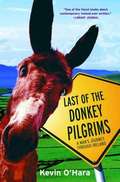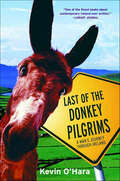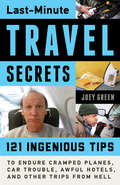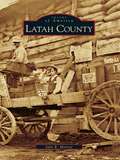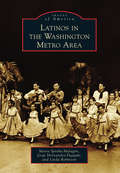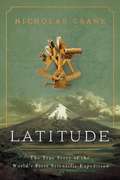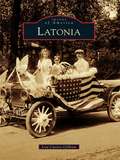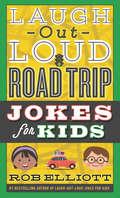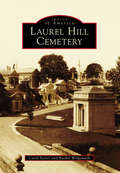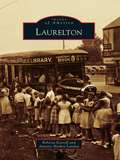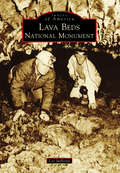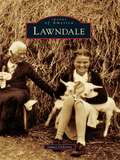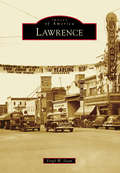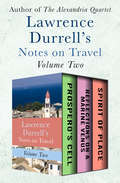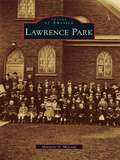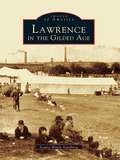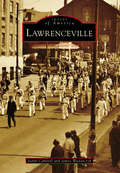- Table View
- List View
Last Train to Texas: My Railroad Odyssey (Railroads Past And Present Ser.)
by Fred W. FraileyA veteran railroad columnist takes readers on a wild ride through the American train industry with remembrances that crisscross the country and the world.In Last Train to Texas, author Fred W. Frailey examines the workings behind the railroad industry and captures incredible true stories along the way. He vividly portrays the industries larger-than-life characters, such as William “Pisser Bill” F. Thompson, who weathered financial ruin, bad merger deals, and cutthroat competition, all while racking up enough notoriety to inspire a poem titled “Ode to a Jerk.”Whether he’s riding the Canadian Pacific Railway through a blizzard, witnessing a container train burglary in the Abo Canyon, or commemorating a poem to Limerick Junction in Dublin, Frailey’s journeys are rife with excitement, incident, and the spirit of the rails. Filled with humorous anecdotes and thoughtful insights into the railroading industry, Last Train to Texas is a grand adventure for the railroad connoisseur.
Last Train to Texas: My Railroad Odyssey (Railroads Past And Present Ser.)
by Fred W. FraileyA veteran railroad columnist takes readers on a wild ride through the American train industry with remembrances that crisscross the country and the world.In Last Train to Texas, author Fred W. Frailey examines the workings behind the railroad industry and captures incredible true stories along the way. He vividly portrays the industries larger-than-life characters, such as William “Pisser Bill” F. Thompson, who weathered financial ruin, bad merger deals, and cutthroat competition, all while racking up enough notoriety to inspire a poem titled “Ode to a Jerk.”Whether he’s riding the Canadian Pacific Railway through a blizzard, witnessing a container train burglary in the Abo Canyon, or commemorating a poem to Limerick Junction in Dublin, Frailey’s journeys are rife with excitement, incident, and the spirit of the rails. Filled with humorous anecdotes and thoughtful insights into the railroading industry, Last Train to Texas is a grand adventure for the railroad connoisseur.
Last of the Donkey Pilgrims: A Man's Journey Through Ireland
by Kevin O'HaraKevin O'Hara's journey of self-discovery begins as a mad lark: who in their right mind would try to circle the entire coastline of Ireland on foot and with a donkey and cart no less? But Kevin had promised his homesick Irish mother that he would explore the whole of the Old Country and bring back the sights and the stories to their home in Massachusetts. Determined to reach his grandmother's village by Christmas Eve, Kevin and his stubborn but endearing donkey, Missie, set off on 1800-mile trek along the entire jagged coast of a divided Ireland. Their rollicking adventure takes them over mountains and dales, through smoky cities and sleepy villages, and into the farmhouses and hearts of Ireland's greatest resource --its people. Along the way, Kevin would meet incredible characters, experience Ireland in all of its glory, and explore not only his Irish past, but find his future self.
Last of the Donkey Pilgrims: A Man's Journey Through Ireland
by Kevin O'HaraKevin O'Hara's journey of self-discovery begins as a mad lark: who in their right mind would try to circle the entire coastline of Ireland on foot—and with a donkey and cart no less?But Kevin had promised his homesick Irish mother that he would explore the whole of the Old Country and bring back the sights and the stories to their home in Massachusetts. Determined to reach his grandmother's village by Christmas Eve, Kevin and his stubborn but endearing donkey, Missie, set off on 1800-mile trek along the entire jagged coast of a divided Ireland. Their rollicking adventure takes them over mountains and dales, through smoky cities and sleepy villages, and into the farmhouses and hearts of Ireland's greatest resource—its people. Along the way, Kevin would meet incredible characters, experience Ireland in all of its glory, and explore not only his Irish past, but find his future self.“One of the finest books about contemporary Ireland ever written...In a style evocative of Steinbeck's Travels with Charley, O'Hara writes memorably of his most unusual way of touring his ancestral home of Ireland.” —Library JournalAt the Publisher's request, this title is being sold without Digital Rights Management Software (DRM) applied.
Last-Minute Travel Secrets: 121 Ingenious Tips to Endure Cramped Planes, Car Trouble, Awful Hotels, and Other Trips from Hell
by Joey GreenThe golden days of complimentary in-flight champagne and cushy sleeping car coaches on the Orient Express are largely behind us. Say hello to $50 "leg room upgrade" fees and bedbug-infested hotels. What's a weary, frustrated traveler to do? Ask Joey Green for advice, that's what! A lifelong world explorer, Green has collected more than a hundred of his best travel hacks to rescue your hard-earned vacation using common, easily-found products. Some of the tips may seem goofy at first but work in a pinch. Insert tampon ear plugs and ignore the stares--enveloped in silence, you can enjoy reading this book's numerous entertaining sidebars and fascinating pieces of travel trivia, comforted in knowing that you will never see, or hear, those fellow passengers ever again.
Latah County (Images of America)
by Julie R. MonroeIts name derived from the Nez Perce language, Latah County is the only county in the United States to have been created by an Act of Congress. The abundance of its natural resources--from blue fields of camas to deep veins of gold, from great stands of white pine trees to vast green grasslands--attracted a diversity of dreamers seeking only the opportunity to build their own futures. Nestled in the heart of the Palouse, an agricultural area of extraordinary production, Latah County is a land of timber and, at Potlatch, was once the site of one of the largest sawmills in the world. At Moscow, it is also the home of the state's land-grant institution, the University of Idaho. From the forests of Troy and the ridges of Juliaetta and Kendrick, from the homesteads of Genesee to Bovill's hunting lodge and Deary's town site, Latah County has had a rich and varied history.
Lathrop
by Mac Freeman Jennifer PyronFirst home to Yokut Indians, then trappers, hunters, and fishermen, Lathrop was founded by Leland Stanford in 1869 as a railroad town and an answer to Stanford's frustration with his railroad attempts in Stockton. Lathrop's rich history includes the railroad, its Delta waterways, manufacturing and distributing industries, and the fascinating tale of California Supreme Court justice David S. Terry's murder (Terry had previously fought and won the last legal duel in California with U.S. senator David C. Broderick just outside of San Francisco). Reportedly named in honor of a relative of Leland Stanford Jr., today's Lathrop evolved from rugged railroad beginnings to a growing and vibrant community of close to 20,000 residents.
Latino History in Rhode Island: Nuestras Raices (American Heritage)
by Marta V. Martínez Albert T. KlybergIn 1956, the Rosarios came to Providence and opened the first Hispanic food market in Rhode Island. This Dominican family's move signaled a new era of Latin American migration for the Ocean State. In the mid-1960s, Guatemalans came to Rhode Island as refugees from the dirty war at home, and Puerto Ricans arrived in the 1920s looking for agricultural work. From the Colombian factory workers who settled in Central Falls in the mid-1960s to the Cubans who fled Castro's revolution in the 1950s and 1960s, Latin Americans were flocking to the coastal towns and quaint neighborhoods of Rhode Island looking for brighter futures and a place to call home. Join author Marta V. Martinez as she turns a collection of oral histories into a fascinating story of the birth of Rhode Island's vibrant Latino community.
Latinos in the Washington Metro Area (Images of America)
by Linda Robinson Jorge Hernandez-Fujigaki Maria Sprehn-MalagónThe Latino presence in the Washington, DC, metropolitan area has diverse roots and a rich history. The earlier residents were relatively small in number, but the Latino population increased dramatically in the late 20th century. Today, this unique Latino community is the 12th largest in the nation. While people of Salvadoran origin are the most numerous, this area is also home to those who hail from Mexico, Puerto Rico, Guatemala, Cuba, the Dominican Republic, Bolivia, Argentina, Chile, Colombia, Ecuador, Honduras, Nicaragua, Paraguay, Peru, Spain, Uruguay, and many other nations and cultures. This book highlights the early days of the Hispanic Festival, the Central American peace movement, the struggle for civil and immigrants� rights, and notable residents. With a shared immigrant experience and broad cultural bonds, these and many other Latino residents have transformed the Washington, DC, area.
Latitude: The True Story of the World's First Scientific Expedition
by Nicholas CraneLatitude is a gloriously exciting tale of adventure and scientific discovery that has never been told before.Crane, the former president of the Royal Geographic Society, documents the remarkable expedition undertaken by a group of twelve European adventurer-scientists in the mid-eighteenth century. The team spent years in South America, scaling volcanoes and traversing jungles before they achieved their goal of establishing the exact shape of the Earth by measuring the length of 1 degree latitude at the equator. Their endeavors were not limited to this one achievement. Not only did their discovery open up the possibility for safe, accurate navigation across the seas, they also discovered rubber and quinine. With a narrative that reads like it was taken from the script of an adventure movie, Nicholas Crane brings to life a narrative that is a timely remind of how scientific discovery can change the world and our future. By knowing the shape of the earth we can create maps, survive the oceans, navigate the skies, and travel across the globe. Without latitude, maps and navigation wouldn&’t be accurate, lives would have been lost, and exact locations of cities and rivers would never be known. After ten grueling years in search of a magic number, the survivors returned to Europe with their historical discovery and fueled the public&’s interest in science. Twent-five years ago, Dava Sobel&’s bestselling Longitude was a global publishing phenomenon, yet it told only one half of the story. With Latitude, this cornerstone piece of our shared history is now complete with this tale of a trip that changed the course of human civilization. Filled with raw excitement and danger, Latitude brings the challenges that faced these explorer-scientists to vivid life.
Latonia
by Lisa Curtiss GillhamThe Latonia Racetrack, opened in 1883, was one of the country's finest. Its presence spurred development, and the resulting town eventually took its name from the famous track. Latonia flourished with the help of the railroad, which carried visitors into town and hauled coal from the mining regions of southeastern Kentucky. The racetrack and railroad made Latonia a bustling center of activity and brought characters from all walks of life. Railroaders and stable boys tipped their hats to wealthy celebrities arriving to play the odds at the track. Famous jockeys, church-going housewives, and con men crossed paths at the racetrack and at Ritte's Corner. Named for a saloon, Ritte's Corner was considered the heart of Latonia, and it was a place where townspeople gathered to socialize, swap stories, and get the latest news. In 1909, Latonia was annexed by Covington, but it continues to be a neighborhood with its own identity and a place families call home, generation after generation.
Lauderdale-By-The-Sea (Images of America)
by Frank J. CavaioliLocated on Florida's Gold Coast, Lauderdale-By-The-Sea is noted for its beach activities, living reef system, and family-oriented lifestyle. The quiet beauty of the sea and sand amid friendly low-rise lodgings and quaint stores and restaurants draws visitors to this thriving paradise year-round. Lauderdale-By-The-Sea developed slowly around the original platted land set down by William F. Morang in 1924 as he and others promoted a land boom. The completion of the Flagler Railroad by 1900 paved the way for regional growth. Lauderdale-By-The-Sea lacked a railroad terminal and remained undeveloped in the early years. Melvin I. Anglin pioneered in chartering the town in 1927 and became its first mayor. Two hurricanes and the 1929 stock market crash burst the real estate bubble, leading to the demise of the charter in 1933. In 1947, citizens drew up a new charter that was certified by the state legislature two years later. Construction of the Anglin Pier in 1941 and the Commercial Boulevard Bridge over the Intracoastal Waterway in 1965 broke down the isolation of the town. Annexation of the unincorporated area north to Pompano Beach completed its growth cycle.
Laugh-Out-Loud Road Trip Jokes for Kids (Laugh-Out-Loud Jokes for Kids)
by Rob Elliott GearboxFrom the #1 bestselling author of Laugh-Out-Loud Jokes for Kids comes a brand-new collection filled with hundreds of jokes and riddles perfect for trains, planes, and automobiles—and featuring, for the first time ever, games and puzzles to keep the whole family busy for hours! This year, when school lets out and the kids are raring to go, hit the road with Rob Elliott’s first-ever summer joke collection. An ideal choice for taking to the pool, on summer sleepovers, or on a long, winding car ride!Q: What kind of people travel the most? A: Romans!
Laurel
by Ann Kooistra-ManningEarly Laurel, like many Montana frontier towns, was shaped by tenacious settlers who struggled to carve a living from a harsh, often unforgiving landscape in the wake of the Indian Wars. Laurel started as little more than a railway station and a handful of businesses serving railroad workers, farmers, and ranchers in the early 1880s. Irrigation projects soon transformed the dry, dusty prairies along the Yellowstone River near Laurel into productive farmlands. Homesteaders flocked to the valley. By 1908, Laurel had grown into a bustling shipping and servicing center for three major railroads and boasted the largest rail yard and roundhouse between Seattle and St. Paul. In the 1920s, it became a jumping-off point for tourists destined for Yellowstone Park. A decade later, Laurel staked its claim in the region's emerging oil industry when the Laurel Leaf refinery was built. This small, unassuming town has played a vital role in the development of the Yellowstone River Valley and beyond.
Laurel Hill Cemetery
by Carol Yaster Rachel WolgemuthEstablished in 1836, Philadelphia’s Laurel Hill Cemetery was one of the earliest rural cemeteries in America. The picturesque views and outstanding horticulture, along with sculptures and monuments designed by notable artists and architects—like Alexander Milne Calder, Alexander Stirling Calder, Harriet Frishmuth, John Notman, and Thomas Ustick Walter—attracted thousands of visitors. Laurel Hill became the desired place of burial for Philadelphia’s elite and the final resting place for those with last names like Widener, Wharton, Meade, and Elkins. The cemetery’s design was much admired and widely imitated, both locally and nationally. While the 20th century ushered in a steep decline for Laurel Hill, the establishment of a friends group in 1978 and the cemetery’s designation as a National Historic Landmark in 1998 signaled a transformation for the cemetery. Laurel Hill entered a new century as a revitalized and relevant institution. Once again, the cemetery is regarded as an important part of the community, a worthy destination for visitors, and a place to share in the stories of the men and women whose lives shaped both Philadelphia and the nation.
Laurelton
by Roberta Kossoff Annette Henkin LandauWhen the 13 colonies declared their independence from the British, the area of Queens that eventually became Laurelton consisted of woodlands, ponds, and farms. This rural community gained some recognition when an attempt to build an upscale housing development for wealthy New Yorkers failed, but left in its place an elegant, new Long Island Railroad Station named "Laurelton." In 1929, the stock market crash and Depression led New Yorkers to the discovery that home ownership was a thrifty alternative to renting. As Laurelton was a beautiful and safe area, real estate boomed. The neighborhood experienced a momentous ethnic change in the 1970s, and within 20 years 80 percent of Laurelton's population was Afircan American and Caribbean middle-class professionals. Laurelton is in the eighth-wealthiest council district in New York City, and its reputation for beauty and community involvement continues.
Lava Beds National Monument
by Lee JuilleratThe region in far northeastern California encompassed by Lava Beds National Monument is often called the "Land of Burnt Out Fires." The name reflects a landscape created by fiery volcanic forces, including cataclysmic events that created more than 700 lava tube caves and an aboveground landscape shaped and fractured by lava flows and other geologic turmoil. Despite its tortured landscape, the region has also been a place of human habitation for thousands of years. Early natives traveled through the lava beds as part of their seasonal travels for food and shelter. The Modoc Indians' knowledge of that landscape, a natural lava fortress now known as Captain Jack's Stronghold, was used during the Modoc War of 1872 and 1873. Modocs, settlers, and others who followed--sheep ranchers, homesteaders, cave discoverers, tourists, spelunkers, and US Forest Service and National Park Service managers--have played prominent roles in creating the region's, and Lava Beds National Monument's, always evolving human history.
Lawndale
by James OsborneLocated in the exact geographical center of Los Angeles County's South Bay district, Lawndale was originally barley fields, then chicken ranches and small farms, growing vegetables for sale in nearby Inglewood and Redondo Beach. Retaining some of its rural character even after World War II, Lawndale gradually transformed into suburbia along with nearby communities, fighting all the while to retain its own identity and staving off aggressive annexation bids by surrounding cities. Finally in 1959, Lawndale incorporated, ending civic contentiousness. Despite the bustle of the high-end Galleria at South Bay, as well as Lawndale's close proximity to some of the most tourism-friendly beach cities in California and its bisection by L.A.'s busiest freeway, the I-405, the city's neighborhoods on the outskirts of Los Angeles International Airport retain the quiet ambiance evinced by its bedroom-community name.
Lawrence
by Virgil W. DeanWith its skyline dominated by the campus of the University of Kansas, the history of Lawrence cannot be divorced from the history of the academy, its influence, and impact. The history of any town, however, is much more than the story of one institution or issue. Lawrence is also a river town, located in an agriculturally rich valley, and Massachusetts Street, its main commercial street, harkens back to its mid-19th century New England origins and influences. Lawrence is also a place of diversity and change, a community where space is contested and disparate opinions make for vital public discourse.
Lawrence Durrell's Notes on Travel Volume One: Blue Thirst, Sicilian Carousel, and Bitter Lemons of Cyprus
by Lawrence DurrellTravel writing &“as luminous as the Mediterranean air&” from the acclaimed author of the Alexandria Quartet, who is featured in PBS&’s The Durrells in Corfu (Time). Born in India, acclaimed British novelist and poet Lawrence Durrell lived in Corfu as a young man, enjoying salt air, cobalt water, and an unfettered bohemian lifestyle, along with his brother, Gerald, who would also go on to be a writer and a naturalist. Their real-life family is portrayed in the PBS Masterpiece production, The Durrells in Corfu. Over the following decades, he rambled around the Mediterranean, making homes in Egypt, Cyprus, and Greece, always bringing his poet&’s eye to document his experiences. Blue Thirst: In the first of a pair of lectures, given during a 1970s visit to California, Durrell recalls his family&’s time living on the Greek island of Corfu, expanding on his eloquent memoir, Prospero&’s Cell. When the Second World War came to the Mediterranean, Durrell was swept into diplomatic service, an adventure he vividly recounts in his powerful second lecture. &“[Durrell&’s] travel books arrive like long letters from a civilized and very funny friend.&” —Time Sicilian Carousel: For years, Durrell&’s friend Martine had begged him to visit her on the sun-kissed paradise of Sicily, but it took her sudden death to finally bring him to the island&’s shores. With Martine&’s letters in his pocket, Durrell treks from sight to sight, dizzy with history and culture, and finds haunting echoes of his past lives in Rhodes, Cyprus, and Corfu. &“Elegant . . . wonderful.&” —Time Bitter Lemons of Cyprus: Against the backdrop of the push for independence on Cyprus in the early 1950s, the poet, novelist, and former British government official buys a house, secures a job, and settles in, yearning for a return to the island lifestyle of his youth. Winner of the Duff Cooper Prize, this memoir is an elegant picture of island life in a changing world. &“Brilliant depth of language . . . gathering slowly from the lighter delightful pages to its lost and questioning end. Never for a moment does [Durrell] lose the poet&’s touch.&” —The New York Times
Lawrence Durrell's Notes on Travel Volume Two: Prospero's Cell, Reflections on a Marine Venus, and Spirit of Place
by Lawrence DurrellTravel memoirs “as luminous as the Mediterranean air” from the acclaimed author of the Alexandria Quartet, who is featured in The Durrells in Corfu (Time). Born in India, acclaimed British novelist and poet Lawrence Durrell lived in Corfu as a young man, enjoying salt air, cobalt water, and an unfettered bohemian lifestyle, along with his brother, Gerald, who would also go on to be a writer and a naturalist. Their real-life family is portrayed in the PBS Masterpiece production, The Durrells in Corfu. Over the following decades, he rambled around the Mediterranean, making homes in Egypt, Cyprus, and Greece, always bringing his poet’s eye to document his experiences. Prospero’s Cell: Along with his family, Lawrence Durrell spent four youthful years on Corfu, an island jewel with beauty to match its fascinating history. While his brother, Gerald, was collecting animals as a budding naturalist, Lawrence fished, drank, and lived with the natives in the years leading up to World War II, sheltered from the tumult that was engulfing Europe—until finally he could ignore the world no longer. Durrell left for Alexandria, to serve his country as a wartime diplomat, but never forgot the wonders of Corfu, captured so beautifully in this “brilliant” memoir (The Economist). “In its gem-like miniature quality, [Prospero’s Cell] is among the best books ever written.” —The New York Times Reflections on a Marine Venus: After four tortuous wartime years in Egypt, Durrell finds a post on the island of Rhodes, where the British are attempting to return Greece to the sleepy peace it enjoyed in the 1930s. From a dip in the frigid Aegean Sea, which jolts him awake for what feels like the first time in years, Durrell breathes in the joys of island life, meeting villagers, eating exotic food, and throwing back endless bottles of ouzo. “Sparkles with . . . intense energy . . . brilliance and fire.” —The Christian Science Monitor Spirit of Place: In these letters and essays, Durrell exhibits the power of poetic observation that continues to make his travel writing so vivid and fresh. He traveled not to sightsee but to live, and made homes in the Mediterranean, Egypt, France, Yugoslavia, and Argentina. Each time he landed, he rooted himself deep into the native soil, taking in not just the sights and sounds of his new land, but the essential character of the country, which he brings to life in these pages. “The letters depict the brio of Durrell’s existence with intoxicating vividness.” —The New York Times
Lawrence Park
by Marjorie D. McleanLawrence Park was planned, developed, and built by the General Electric Company in 1910, when the company decided to build their plant near Erie, Pennsylvania. However, Lawrence Park was not to be a company town, but rather a planned community in the "English garden" concept. The tree-lined streets, flowering boulevards, and delightful parks are a testimony to those visionaries. Around 1900, the elegant Grove House Hotel was built on the banks of beautiful Lake Erie, and later a lively amusement park flourished there. The Stone House, built in 1832 and rumored to be a station in the Underground Railroad, still stands at the crossroads. The early settlers of Lawrence Park laid the foundation for a caring community that today enthusiastically embraces school and community activities.
Lawrence in the Gilded Age
by Louise Brady SandbergThe Gilded Age, c. 1870-1898, was a time of promise and expanding horizons for the people of Lawrence, known as "the Queen City on the Merrimack." Passenger trains, horse-drawn trolleys, and electric streetcars dominated transportation, one-third of the population worked in manufacturing, and thirteen newspapers brought the latest information to the city's burgeoning population of nearly sixty thousand people. Through unique images from the special collections of the Lawrence Public Library, rich commentary, and a virtual walking tour, Lawrence in the Gilded Age relives the last three decades of the nineteenth century in Lawrence, which had managed to avoid the labor strikes and political and social unrest that plagued the city in the early twentieth century.
Lawrenceville
by James Wudarczyk Joann CantrellFrom its founding in 1814 by William Barclay Foster, Lawrenceville has been the center of historic events. During the Civil War, the riverside community became home to the Allegheny Arsenal, where 78 people perished in an explosion in 1862, making it the worst civilian disaster of the war. Lawrenceville evolved into a lively, walkable neighborhood that barely slept because of the high volume of shift workers at places such as Iron City Brewery, St. Francis Hospital, and the steel mills. Businesses, churches, all-night diners, and other gathering places were easily accessible to residents, and families became closely associated with the landmarks where they worked, worshipped, and socialized. Having celebrated its 200th birthday in 2014, Lawrenceville remains a bustling community with a vitality equal to that of the immigrant days, and it continues to be a place of camaraderie where individuals are dedicated to their neighborhood.
Le Cinema Francais: An Illustrated Guide to the Best of French Films
by Anne Keenan HigginsLe Cinéma Français is an irresistible illustrated guide and primer to the best of French films, starting with the 1950s, through the spectrum of French New Wave, and on to modern-day confections.Starring the likes of Brigitte Bardot, Catherine Deneuve, and Jeanne Moreau, and directed by iconoclasts such as Francois Truffaut, Eric Rohmer, and Jean-Luc Godard, French movies are as touching, beautiful, and romantic as they come in all of film. Le Cinéma Français captures their spirit in whimsical detail. Each movie is covered with a plot summary; back stories; and illustrations by author/artist Anne Keenan Higgins of highlight scenes, costumes, props, and characters that are as enchanting as the films themselves.This gorgeously gifty tribute to French cinema is not just for movie buffs or followers of international films, but for all who are enchanted by French culture.

